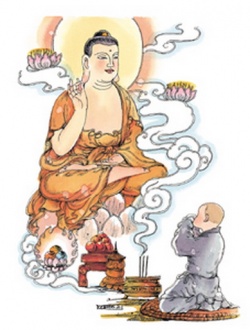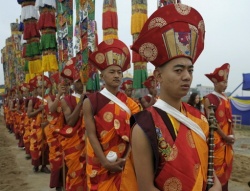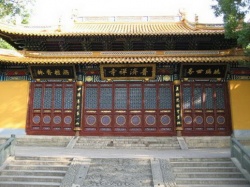Bon-po books of the dead
Before the arrival of Buddhism from India sometime in the seventh century A.D., Tibetan religious practice was focused largely on the person of the king. Since it was held that the welfare of Tibet depended upon the welfare of its ruler, special rituals were performed to protect and prolong the king's life, and when dead, to guarantee his safe passage to the heavenly mountains.
According to some of the early historical sources, the priests that performed such rituals were identified by the name "bon- po" and their beliefs by the term "bon." Although it is commonly claimed that this ancient pre-Buddhist class of Tibetan priests became the Bon religion of modern times, historical evidence indicates that Bon developed into an organized and distinctive religious tradition only in deliberate opposition to Buddhism as late as the tenth century. Thus, more than likely, a genuine pre-Buddhist Bon religion never truly existed.
In other words, the development of Buddhism and Bon were separate but simultaneous processes within the whole range of Tibetan religion. Over the centuries the mixture of indigenous Tibetan beliefs and practices with those of Buddhism (and Bon) has succeeded in almost completely obscuring any distinctions between the two.
What appears to be certain is that early Tibetan religion revolved essentially around ideas about the creative and destructive powers of the earth and the nature and persistence of the soul or la (bla) after death.
Certain elements of these ideas have survived and can be discerned in Bon-po (or, as the case may be, in Buddhist)
literature, but such ideas themselves are fundamentally different from the basic doctrines of the Bon religion that originally had been instituted only after the arrival of Buddhism in Tibet (and that continue to be practiced today).
The Bon texts in this section of the exhibit reflect the creative tension between the two opposing traditions of Buddhism and Bon, and reveal a number of Tibetan ideas on death and the hereafter that have more or less survived from ancient times.
Given certain significant differences in age (the Bon text being nearly two centuries older than its Buddhist counterpart), symbolism, and iconographic personality (the many Bon-po deities, of course, have different names), The Lamp that Illuminates the Liberation upon Hearing is more or less parallel in content to that of the more familiar Tibetan Book of the Dead.
Both versions are classified as a type of literature known in Tibetan as tö-dröl or "that which liberates through hearing alone" (thos grol), an expression that appears prominently in the titles of the texts themselves.
As we have seen above, the teachings contained in the tö-dröl texts are intended to awaken in the consciousness of the deceased the understanding and recognition of the many visions encountered in the bardo state.
Ideally, these instructions are directed toward individuals who have dedicated themselves to mystical training in yoga and meditation.
On the other hand, for those ordinary individuals who are not as familiar with advanced meditative techniques, the instructions of the Liberation upon Hearing are meant to be read out loud by a teacher, after a person has died, to help guide him or her through the bewildering sensations of the bardo experience.
This form of revelatory transmission is called a "mind treasure" or gongter (dgongs gter). In most cases of this type of revelation, the original holder of the doctrine (e.g., Dampa Rangdröl), through special esoteric powers, conceals the teaching in the mind of a chosen disciple, where it remains hidden until a later more appropriate time.
Then, the doctrine is mystically revealed in the mind of that disciples future reincarnation (e.g., Kundröl Drakpa), who either records it in writing or transmits it orally to his students.
This famous mind treasure of Kundröl Drakpa offers a detailed presentation of the standard Bon-po doctrines on death, intermediate state, and rebirth, with special emphasis on the symbolism of the Peaceful and Wrathful Deities that appear in the Bardo of Reality.
Moreover, the text clearly demonstrates the close relationship that exists between Bon-po and Buddhist interpretations of the bardo state.
In this context, the methods referred to are the transference of consciousness at the moment of death (phowa), the reading of the "liberation through hearing" texts (tö-dröl), and the summoning of the deceased's consciousness using ceremonial illustration cards (jangbu).
Since these techniques have been discussed previously in various sections of our exhibit, we should mention briefly the Bon-po rites of exorcism, which are described in detail in our texts and form part of the precautionary rites performed just before the commencement of the larger funeral ceremony.
According to the ritual texts, the moment just after death marks the beginning of a critical period in which the corpse becomes vulnerable to attacks by demons.
These evil beings may enter the body and reanimate it, in some cases assuming the form of a zombie or ro-lang (ro langs, "a corpse that has risen").
To guard against such attacks the corpse is watched continuously as the exorcism is performed.
A small "ransom effigy" or lü (glud) is carefully crafted and decorated in a manner that will entice the demon and lure it away from the corpse.
By reciting certain magical spells from the exorcism texts, the officiating Bon-po lama tricks the demon into entering the lifeless effigy and traps it there, rendering it powerless.
This demon trap is then carted away in a carnival-like celebration that involves beating drums and shouting loudly to frighten the helpless demon out of the community.
The Lamp that Illuminates the Liberation upon Hearing in the Bardo State:
The Oral Tradition
Tibetan: [[sNyan brgyud bar do thos grol gsal sgron chen mo
Author: Dam pa rang grol ye shes rgyal mtshan (b.1149)
In Zhi khro sgrub skor glegs bam gyi dbuâi rdul len thar lam Îdren byed. Delhi, c.1970.I-Tib-761; 76-924678.
The Great Freedom from the Narrow Path of the Bardo: The Oral Tradition
Tibetan: sNyan brgyud thos grol bar do Îphrang sgrol chen po
Author: Dam pa rang grol ye shes rgyal mtshan (b.1149)
Dolanji, Tibetan Bonpo Monastic Center, 1974. I-Tib-1240; 74-900987.
The instructions on the bardo from the oral tradition of Zhangzhung Valley, which is traced back to the master [[Tönpa
Shenrap]], founder of the Bon religion (see Introduction), are among the oldest recorded concerning knowledge of the
intermediate state in Tibet.
The best known collection of Bon teachings on the bardo is The Lamp that Illuminates the Liberation upon Hearing in the Bardo State:
The Oral Tradition, which is also known by its alternate title The Great Freedom from the Narrow Path of the Bardo.
This so-called "Bon-po Book of the Dead" is a work similar in many respects to the Buddhist version.
The Peaceful and Wrathful Deities: A Collection of Visionary Revelations
Tibetan: Zhi khro dgongs Îdus
Author: Rig Îdzin Kun grol grags pa (b.1700)
Dehra Dun, U.P., Trinley Jamtsho, 1985. I-Tib-2705; 85-902625.
In the early eighteenth century, the great Bon-po treasure revealer (tertön) Rikdzin Kundröl Drakpa (Rig Îdzin Kun grol grags pa, b.1700) had a series of mystical visions of Dampa Rangdröl (Dam pa rang grol, b.1149), the twelfth century author of the "Bon-po Book of the Dead."
In these visions, Dampa Rangdröl awakened in Kundröl Drakpa's mind the teachings contained in the scriptural treasure (terma) entitled The Peaceful and Wrathful Deities:
A Collection of Visionary Revelations.
Death Rituals of the Tibetan Bonpos
Tibetan: ÎDur chog
Author: Khu tsha zla Îod (b.1024)
Dolanji, H.P., Tshultrim Tashi: Tibetan Bonpo Monastic Center, 1983. I-Tib- 2531; 85-900439
Bonpo Funeral Rites Eliminating All Evil Rebirths
Tibetan: Kun rig cho gaâi sgrub skor
Dolanji, Ochghat, H.P., Patshang Lama Sonam Gyaltsen, 1985. I-Tib-2693; 85-902610
The Bon-po funeral ceremonies described in the two large collections of ritual literature entitled Death Rituals of the Tibetan Bonpos and Bonpo Funeral Rites Eliminating All Evil Rebirths consist primarily of three separate series of rites, each corresponding to a stage in the death process--dying, intermediate existence, and rebirth.
These individual rites are also identified by the particular religious method employed to insure an auspicious destiny for the deceased, whether that be final liberation from cyclic existence or rebirth in one of the three higher realms.


